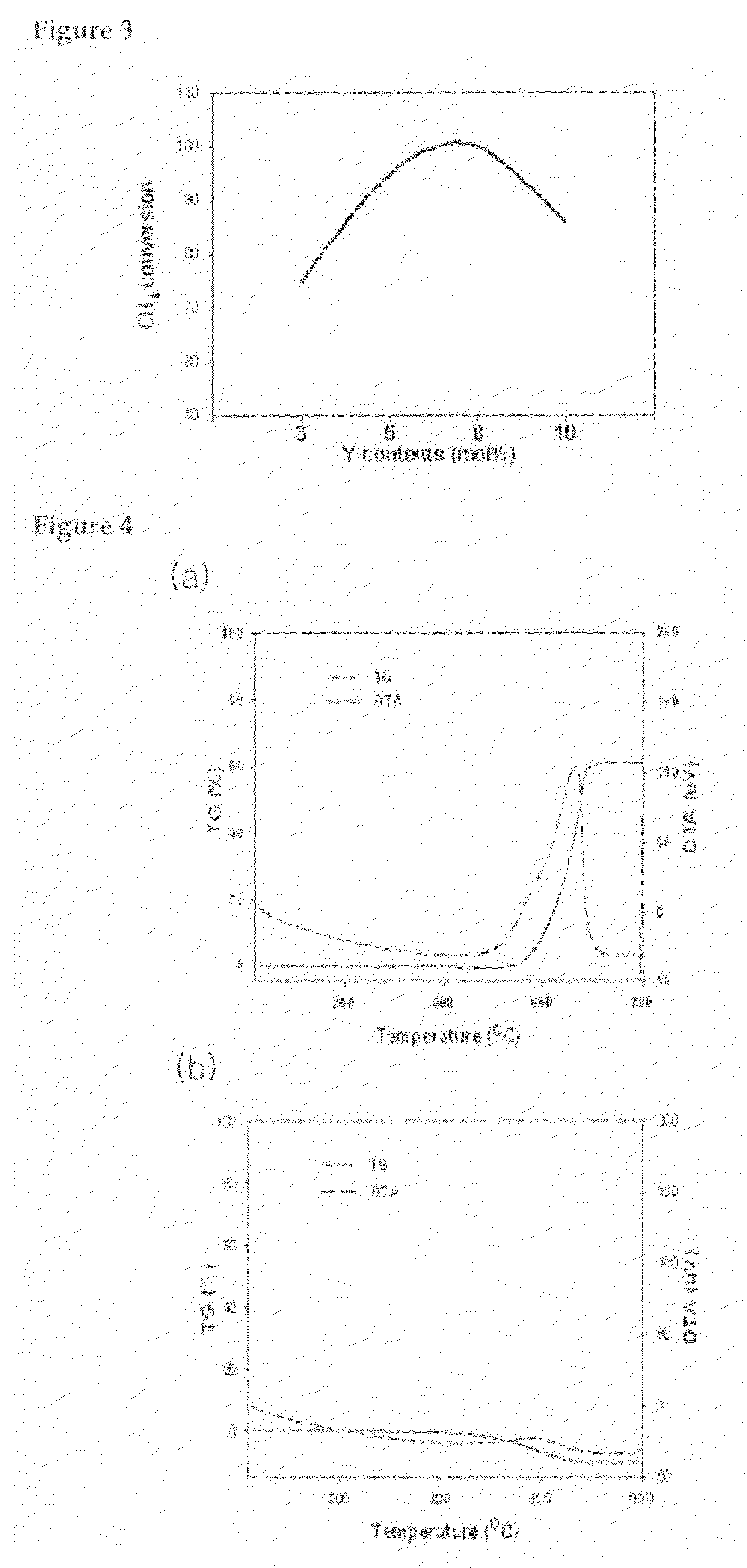Ni-based catalyst for tri-reforming of methane and its catalysis application for the production of syngas
a technology of tri-reform and catalyst, which is applied in the direction of physical/chemical process catalyst, metal/metal-oxide/metal-hydroxide catalyst, etc., can solve the problems of inability to apply noble metal based catalyst to the industry, the deactivation of catalyst due to carbon deposition on the catalyst is a serious problem, and the use of expensive noble metal based catalyst has been suggested
- Summary
- Abstract
- Description
- Claims
- Application Information
AI Technical Summary
Benefits of technology
Problems solved by technology
Method used
Image
Examples
preparatory example 1
Preparation of Support (Y, ZrO2—M)
[0047]Predetermined amounts of ZrO2, YO2 and MOx powders were mixed as shown in Table 1, and 7 vol % of water relative to the volume of the powder mixture, thereby providing slurry. Zirconia balls (0.2 mm) were added into the slurry in the amount of 10-20 times the weight of the slurry, followed by ball-milling mixing and pulverization of the slurry for 24 h. After zirconia balls were removed, solvent was evaporated in an oven (100° C.), thereby providing (Y, ZrO2—M) support.
TABLE 1Support (Y,ZrO2-M)Molar ratio ofWeight ratio ofY relativeM relative toSupportZrO2 (mol %)ZrO2 (wt %)Produced Support1(8)Ce (6)8Y,ZrO2-CeO22(3)Ce (6)3Y,ZrO2-CeO23(10) Ce (6)10Y,ZrO2-CeO24(8)Mg (6)8Y,ZrO2-MgO5(8)Ce (3), Mg (3)8Y,ZrO2-Ce,MgO6(8)Ce (3), Ti (3)8Y,ZrO2-Ce,TiO27(8)Ce (3), Si (3)8Y,ZrO2-Ce,SiO28(8)Ca (6)8Y,ZrO2-CaO
preparatory example 2
Preparation of Catalyst Ni / (Y,ZrO2—M)
[0048]An aqueous nickel solution was loaded on the support (Y, ZrO2—M) prepared according to the impregnation method as described in Preparatory Example 1, thereby providing a Ni-based catalyst for the tri-reforming reaction of methane.
[0049]In a beaker containing 100 mL of distilled water, the support (Y, M—ZrO2) prepared in Preparatory Example 1 was added to give slurry. 1M Aqueous solution of nickel nitrate was added to the slurry, and stirred and dried on a hot-plate (60° C.) for 6 h. After dried in an oven (100° C.) for 12 h, the resultant was calcined in air at 1350° C. for 2 h, thereby providing a catalyst Ni / (8Y, ZrO2—M).
TABLE 2Amount of nickelCatalystSupportloading (wt %)Produced catalyst1140Ni / (8Y,ZrO2-CeO2)2240Ni / (3Y,ZrO2-CeO2)3340Ni / (10Y,ZrO2-CeO2)4440Ni / (8Y,ZrO2-MgO)5540Ni / (8Y,ZrO2-Ce,MgO)6640Ni / (8Y,ZrO2-Ce,TiO2)7740Ni / (8Y,ZrO2-Ce,SiO2)8840Ni / (8Y,ZrO2-CaO)
example 1
Preparation of Syngas by means of Tri-Reforming Reaction of Methane
[0053]The activity of the catalyst was measured by performing the tri-reforming reaction of methane on Ni / (8Y, ZrO2—CeO2) catalyst prepared in Preparatory Example 2.
[0054]As shown in FIG. 1, the tri-reforming reaction of methane was performed using a conventional reactor with the catalyst. The catalyst was pulverized and sieved using 80-100 mesh sieves. The catalyst with the particle size of 150-250 μm was selected and filled into the reactor, followed by the reduction at 800° C. for 2 h under the hydrogen flow. As a reactant gas, gas mixture mixed with methane, carbon dioxide, steam and oxygen in the volume ratio of 1:1:1:0.1 was supplied into the reactor. The reaction temperature was maintained at 650-850° C. using an electric furnace and a pre-programmed auto-controller. The influx of the reactant gas was controlled at a space velocity of 10,000 h−1 using a mass flow controller, thereby providing syngas.
[0055]Upon...
PUM
| Property | Measurement | Unit |
|---|---|---|
| molar ratio | aaaaa | aaaaa |
| molar ratio | aaaaa | aaaaa |
| molar ratio | aaaaa | aaaaa |
Abstract
Description
Claims
Application Information
 Login to View More
Login to View More - R&D
- Intellectual Property
- Life Sciences
- Materials
- Tech Scout
- Unparalleled Data Quality
- Higher Quality Content
- 60% Fewer Hallucinations
Browse by: Latest US Patents, China's latest patents, Technical Efficacy Thesaurus, Application Domain, Technology Topic, Popular Technical Reports.
© 2025 PatSnap. All rights reserved.Legal|Privacy policy|Modern Slavery Act Transparency Statement|Sitemap|About US| Contact US: help@patsnap.com



